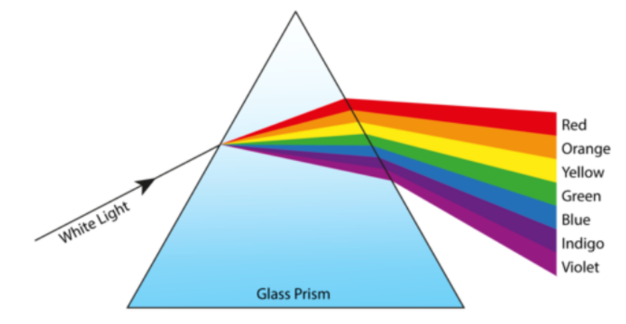
(a) What is dispersion of white light? What is the cause of dispersion? Draw a diagram to show the dispersion of white light by a glass prism.
(b) A glass prism is able to produce a spectrum when white light passes through it but a glass slab does not produce any spectrum. Explain why it is so.
Answer
390.6k+ views
Hint:Here we will understand the phenomenon of dispersion of white light. We will understand the primary cause behind the splitting of the white light into seven colours. A glass prism has the ability to disperse the white light. We will also discuss the reasons why a normal glass slab would not be able to do so.
Complete answer:
(a) Dispersion of white light: The phenomenon of splitting up of white light into seven distinct colours while passing through a glass prism is known as dispersion of white light.
Cause of dispersion of white light: The dispersion of white light occurs due to the fact that different light have different wavelengths. When they strike the glass surface of the glass prism their velocities become different due to different wavelengths, hence their angle of deviation becomes different. So, they split up into seven colours.
Diagram of dispersion of light:

(b) In a glass prism the faces are at some angles to each other. The white light being refracted from the first face splits up into seven components due to their varying wavelengths causing varying angles. Again, they get reflected from the last face of the prism which is also inclined at some angle and hence the components do not merge and come out as distinct seven colours. But, in case of parallel glass slab the light after getting refracted from the first face of the slab gets split into seven colours but after being refracted from the last face which parallel to the first face eventually merges all the distinct colours into white light again.
Note: It must be noted that the light flows through both refraction and dispersion when it passes through the first face of the glass slab. But, while it emerges out of the slab it follows refraction but not dispersion. But in case of a prism both dispersion and refraction happens on the both faces of the prism as they are some angles to each other.
Complete answer:
(a) Dispersion of white light: The phenomenon of splitting up of white light into seven distinct colours while passing through a glass prism is known as dispersion of white light.
Cause of dispersion of white light: The dispersion of white light occurs due to the fact that different light have different wavelengths. When they strike the glass surface of the glass prism their velocities become different due to different wavelengths, hence their angle of deviation becomes different. So, they split up into seven colours.
Diagram of dispersion of light:

(b) In a glass prism the faces are at some angles to each other. The white light being refracted from the first face splits up into seven components due to their varying wavelengths causing varying angles. Again, they get reflected from the last face of the prism which is also inclined at some angle and hence the components do not merge and come out as distinct seven colours. But, in case of parallel glass slab the light after getting refracted from the first face of the slab gets split into seven colours but after being refracted from the last face which parallel to the first face eventually merges all the distinct colours into white light again.
Note: It must be noted that the light flows through both refraction and dispersion when it passes through the first face of the glass slab. But, while it emerges out of the slab it follows refraction but not dispersion. But in case of a prism both dispersion and refraction happens on the both faces of the prism as they are some angles to each other.
Recently Updated Pages
Using the following information to help you answer class 12 chemistry CBSE

Full Form of IASDMIPSIFSIRSPOLICE class 7 social science CBSE

In case of conflict between fundamental rights of citizens class 7 social science CBSE

Can anyone list 10 advantages and disadvantages of friction

What are the Components of Financial System?

Complete the letter given below written to your Principal class null english null

Trending doubts
Which are the Top 10 Largest Countries of the World?

Differentiate between homogeneous and heterogeneous class 12 chemistry CBSE

Draw a labelled sketch of the human eye class 12 physics CBSE

What is the Full Form of PVC, PET, HDPE, LDPE, PP and PS ?

What is a transformer Explain the principle construction class 12 physics CBSE

What are the major means of transport Explain each class 12 social science CBSE




